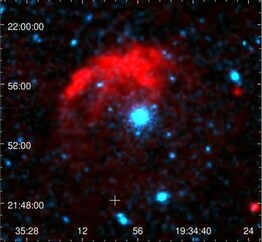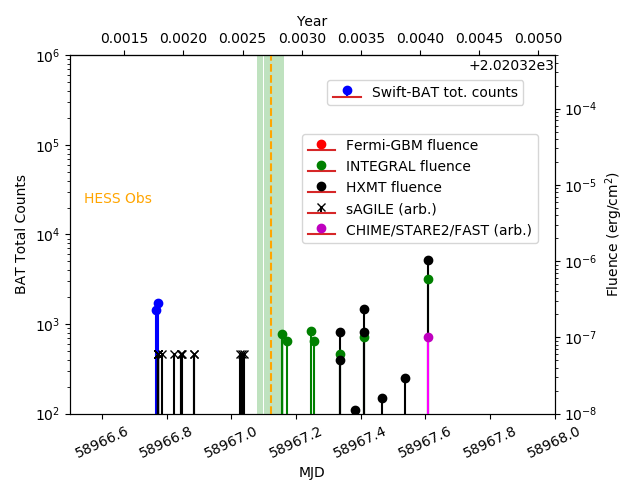|
This post is mainly based on the "Source of the Month" article that I wrote together with Gavin Rowell and which was published on the website of the H.E.S.S. Collaboration. Magnetars are very highly magnetised neutron stars with a surface magnetic field reaching 10^15 Gauss, about 1000x stronger than that derived for 'normal' neutron stars, and among the strongest magnetic fields found in the universe.. They power the so-called soft gamma repeaters (SGRs) and anomalous X-ray pulsars (AXPs), which are well-known for their irregular bursts in X-rays and soft-gamma-rays. During the short (faster than minutes) bursts, the brightness can increase by a factor of 1000 or more. There are only 29 SGRs and AXPs catalogued so far (1). Following its discovery in 2016, SGR J1935+2154 has become probably the most burst-active SGR, emitting dozens of X-ray bursts over the past few years (2) . SGR J1935+2154 has been associated with the middle-aged SNR G57.2+0.8 at a distance of about 6.6 kpc (3) as shown in Fig. 1. Fig.1 SNR G57.2+-0.8 in X-rays (cyan: XMM-Newton 0.4-7.2 keV) and radio (red: THOR VLA 1.4 GHz). The bright X-ray central source is SGRJ1935+2154 and the cross indicates a 1720 MHz OH maser tracing an SNR shock interaction with an adjacent molecular cloud. From Zhou et al. 2020 (3). Following two alerts on 27 April (2020 the first at UT 18:26) from Swift-BAT spaced apart by only 6 minutes, H.E.S.S. observed SGR J1935+2154 for 2hrs on the night of 27/28 April 2020 covering the UT 01:55 to 03:53 period of 28 April 2020. Later that night Swift reported a "forest of bursts from SGR J1935+2154" (4) which was observed just after the initial BAT trigger at UT 18:26. This forest of bursts lasted for about 7 hours and stopped about 1 hour prior to the H.E.S.S. observation window. A more complete list of Swift-BAT bursts is given in (5). Swift, and many other X-ray and soft-gamma-ray telescopes (Fermi-GBM, INTEGRAL, sAGILE, HXMT, Konus-Wind, NICER) have also reported intense activity over this and the following period into late May. Fig. 2 shows the burst history of SGR J1935+2154 compared to the H.E.S.S. observation window. Fig. 2. Left : Multi-year burst history of SGR J1935+2154. Right : Burst history of SGR J1935+2154 zoomed in around the H.E.S.S. 2hr observation window (orange dashed line and green shaded region). Included are the two radio bursts seen by CHIME + STARE2 and FAST discussed below. While this high energy photon activity from SGR J1935+2154 was certainly interesting in its own right, the situation became considerably more notable with the detection of short, intense radio bursts from the direction of SGR J1935+2154. To-date, two millisecond-duration radio bursts have been detected - the first burst by CHIME and STARE2 (6,7), and the second burst by FAST (8). When removing the dispersion delay, the timing of the first radio burst appears to line up very well with one of the bright X-ray bursts seen by INTEGRAL and the Insight-HXMT (9, 10). This overlap is now seen as the first convincing evidence that magnetars are linked to FRBs, or at least, to repeating FRBs. Fig. 3 below shows that CHIME measured two components within the first radio burst seen from SGR J1935+2154. The energy of the burst is about 10^34-10^35 ergs, just below the low end of the extragalactic FRBs distribution observed so far. This discrepancy is likely due to the sensitivity limits of current radio telescopes, thereby biasing towards detection of energetic extragalactic FRBs (6). Fig.3 Left : CHIME "Waterfall" plot of the first radio burst from SGR J1935+2154 showing the two-component structure. Right : Comparison of the radio burst fluence and energy vs. distance with bursts from a variety of other compact sources. Plots from CHIME/FRB Collab. 2020 (6). Fast radio bursts (FRBs) have been one of astronomy's major mysteries since the first accepted example was revealed in 2007 (11) from a burst that actually had occurred in 2001 (radio bursts from M87 reported by (12) in 1980 may in fact be the first examples). Now, over 150 FRBs have been discovered (13), with a small fraction exhibiting repeating radio bursts or even periodicity. Some observational progress in recent years was made via radio interferometric observations, locating FRB predominately towards the outer regions of galaxies within the spiral arms or beyond the central bulge (14). In parallel, radio data analysis pipelines have been tailored to searches for short bursts in almost real-time thus allowing to emit alerts and subsequent searches for emission in other wavelength bands. Although the time-compact nature (milliseconds duration) and burst statistics of FRBs has pointed to a physical link with stellar remnant compact objects such as magnetars (e.g. 15) , the lack of non-radio counterparts to any FRB hampered progress in unambiguously linking them to specific objects. This all changed on 28 April 2020 with the observations of a simultaneous X-ray and radio burst from magnetar SGR J1935+2154. H.E.S.S. searches for VHE emission from FRBs Since the discovery of FRBs, the global astrophysics community is pursuing significant efforts to pin-point the origins of these enigmatic radio pulses. The H.E.S.S. collaboration has a long history in these searches. Since 2014 several partnerships with some of the most sensitive radio observatories like Parkes or UTMOST have allowed to conduct searches for delayed or afterglow emission of FRBs in the VHE domain. The first such search was conducted following the detection of FRB 150418 by the SUPERB team at Parkes and has been published by the H.E.S.S. collaboration in (16). Another, complementary, way to search for MWL emission from various transients and in particular from FRBs, is through coordinated campaigns of various observatories scanning the same part of the sky simultaneously. The most extensive of these endeavors are the Deeper-Wider-Faster campaigns (17) in which H.E.S.S. participates. Since the detection of repeating FRBs like FRB121102 and more recently FRB171019, which is conveniently located in the Southern hemisphere, coordinated MWL campaigns of several instruments can also be tailored to cover these special targets, another attempt which the H.E.S.S. collaboration is actively pursuing. In parallel, H.E.S.S. has been running a target of opportunity (ToO) program tailored to searches for VHE emission from SGRs for many years, using Swift-BAT to provide prompt and afterglow triggers for H.E.S.S. Since 2019, we have extended the program to include a dedicated, automatic analysis of data from Fermi-LAT (18) to guide the H.E.S.S. observations. Alerts on activity of several SGRs and AXPs have been received since 2018, but H.E.S.S. observation conditions had not been favorable. The Swift-BAT alerts from SGR 1935+2154 received on 27 April 2020 was the first time H.E.S.S. was able to observe an SGR under this ToO programme. As shown in Fig. 2 right panel, almost all of the X-ray and radio bursts occurred outside the H.E.S.S. observation window which lasted 2h, however one of the INTEGRAL bursts, burst 'A' as denoted by (9), just overlaps the end of the H.E.S.S. observations. A first analysis of the H.E.S.S. data searching for VHE gamma-ray emission at various timescales has been performed by my PhD student Halim Ashkar. Analyzing the data as a whole (i.e. the total 2h) and searching for variability or short spikes down to timescales of a few minutes, no significant signal could be found. Further analyses related to the INTEGRAL burst 'A' and covering shorter timescales have started. The H.E.S.S. observations at VHE energies of SGR J1935+2154 will be important to constrain the particle acceleration scenarios of magnetars. Relying on very basic assumptions, the X-ray bursts could be indicators for surges in particle acceleration. Should the accelerated particles reach TeV or higher energies during the burst, VHE gamma-ray emission may arise from inverse-Compton scattering of electrons, or from protons colliding with surrounding plasma. On the other hand, pair production and photon splitting could result in significant energy losses for the VHE gamma-rays and typically lead to strong cutoffs in the MeV to GeV energy range. The flux suppression could be avoided in scenarios where the gamma rays are generated well away from the magnetar's intense magnetic field (cf. 19). The H.E.S.S. observations can therefore also probe the particle transport aspects (such as outflows) in the vicinity of SGR 1935+2154 during the recent flaring episode. References
(1) McGill Magentar Catalogue: http://www.physics.mcgill.ca/~pulsar/magnetar/main.html (2) Lin L. et al 893, 156 (2020) (3) Zhou P. et al (2020) https://arxiv.org/abs/2005.03517 (4) ATel 13675 : http://www.astronomerstelegram.org/?read=13675 (5) ATel 13758 : http://www.astronomerstelegram.org/?read=13758 (6) CHIME/FRB collab. (Science submitted) arXiv:2005.10324 (2020); ATel 16381 : http://www.astronomerstelegram.org/?read=13681 (7) ATel 13684 : http://www.astronomerstelegram.org/?read=13684 (8) ATel 13699 : http://www.astronomerstelegram.org/?read=13699 (9) Mereghetti S. et al. ApJ Lett (submitted) arXiv:2005.06335 (2020) (10) HXMT SGR J1935+2154 burst list : http://enghxmt.ihep.ac.cn/bfy/331.jhtml; ATel : 13692 http://www.astronomerstelegram.org/?read=13692 (11) Lorimer D. et al. Science 318, 777 (2007). (12) Linscott I., Erkes J. 1980 ApJ Lett 236, L109 (1980) (13) FRBCat: http://frbcat.org/ (14) Bannister K. et al. Science 365, 565 (2019) (15) Wadiasingh Z. et al. ApJ 879, 4 (2019) (16) H. Abdalla et al. (H.E.S.S. Collaboration), A&A 597, id.A115 (17) I. Andreoni and J. Cooke, Proc. IAU Symposium, Volume 339, pp. 135-138 (18) J.-P. Lenain, Astronomy and Computing, Volume 22, p. 9-15. (19) Kun H., et al MNRAS 486, 3327 (2019)
0 Comments
Leave a Reply. |
AuthorMyself ;-) Archives
January 2024
Categories
All
|





 RSS Feed
RSS Feed